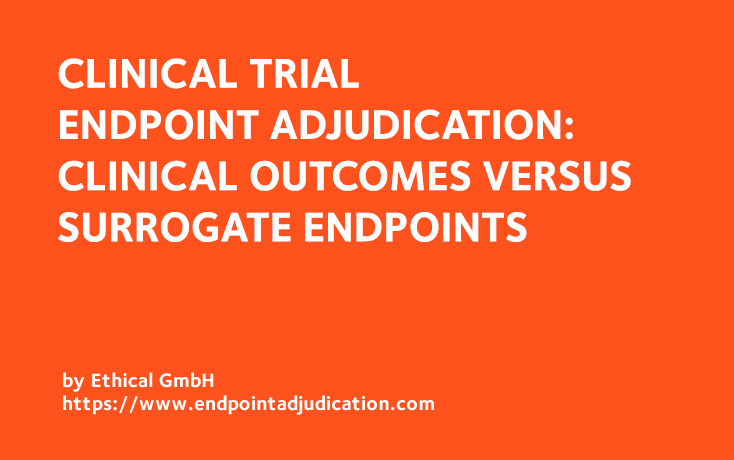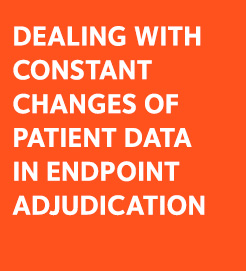Clinical trial endpoint adjudication has emerged as a major part of clinical trials in the past years. Increasing complexity of trial design combined with growing requirements from Health Authorities have resulted in a higher demand for independent blinded review and adjudication of both efficacy and safety endpoints. The ease of exchange of data and documents made possible by the use of cloud-based software platforms has allowed experts to review complex endpoints in real time while remaining blinded to any personal or treatment identifiers. However, only a portion of new drugs are approved on the basis of direct outcomes and, in many cases, surrogate endpoints are used to measure the effects of investigational medicines. How good are the platforms in handling these surrogate endpoints and how easy or difficult is it for adjudicators to assess them?
Clinical trials are conducted to demonstrate that new medical products deliver a positive balance of benefit and risk. In order to do that, the disease burden and the progression of the patients’ status under the use of an investigational drug must be measured in the most precise way possible. The parameters used for such measurement are called Clinical Trial Endpoints. These can be direct, based on clinical outcomes, or indirect, called “surrogate” endpoints. While clinical outcomes may reflect directly the disease status, they may not always be easy to assess and therefore to adjudicate should adjudication be prescribed. Surrogate endpoints have been developed to facilitate the assessment. Between 2010 and 2012, the FDA approved 45 percent of new drugs based on a surrogate endpoint and has published a table with more than 120 surrogate endpoints that were the basis of drug approval or licensure1.
The FDA has published extensive descriptions and definitions of the different types of clinical outcomes and endpoints listed below2 and has created a Clinical Outcomes Assessment (COA) Compendium3.
What are clinical trial endpoints?
A clinical trial’s endpoints measure the outcomes in the trial. When a trial evaluates the efficacy of a new medical product or a new use for an approved product, investigators may choose endpoints that directly measure the clinical outcome they want to study. Alternatively, they may choose an endpoint that is a substitute, or “surrogate”, for the outcome they want to study.
Clinical outcomes directly measure whether people in a trial feel or function better, or live longer. The benefit or likely benefit of a therapy, as measured by clinical outcomes (e.g., improvement in symptoms), is assessed to determine whether it outweighs any adverse effects (e.g., drug-induced liver injury).
Clinical outcome assessments (COAs) is a parameter that reflects how an individual feels or functions, or how long the person lives. Although COAs are often used to determine whether or not a drug used in a clinical trial provides a treatment benefit, COAs are measured using a report generated by a clinician, patient, non-clinician observer, or a performance-based assessment.
The COA Compendium3 is part of FDA’s efforts to foster patient-focused drug development. The COA Compendium is intended to facilitate communication and to provide clarity and transparency to drug developers and researchers by collating and summarizing clinical outcome assessment (COA) information for many different diseases and conditions into a single resource.
The COA Compendium is a table that:
- Describes how certain COAs have been used in clinical trials to measure the patient’s experience (such as disease-related symptoms) and to support labeling claims.
- Identifies COAs that have been qualified for potential use in multiple drug development programs under CDER’s Drug Development Tool (DDT) Qualification Program
Surrogate endpoints may be used instead of clinical outcomes in some clinical trials. For example, surrogate endpoints are used when the clinical outcomes, like strokes, might take a very long time to study, or in cases where the clinical benefit of improving the surrogate endpoint, such as controlling blood pressure, is well understood. They are also used in cases where conducting a clinical endpoint study would be unethical. Before a surrogate endpoint can be accepted in place of a clinical outcome, extensive evidence of their reliability must accumulate, including evidence from epidemiological studies and clinical trials. Usually clinical trials are needed to show that the surrogate endpoint can be relied upon to predict, or correlate with, clinical benefit in a context of use. Surrogate endpoints that have undergone this extensive testing are called validated surrogate endpoints and these are accepted by the FDA as evidence of benefit. Biomarkers are a type of surrogate endpoints increasingly used in clinical development as well as in clinical practice.
Why are surrogate endpoints important for medical product development?
When a surrogate endpoint clearly predicts a beneficial effect through appropriate studies, its use generally allows for more efficient drug development programs. For example, many clinical trials, using a range of different blood pressure lowering medications, have demonstrated that reducing systolic blood pressure reduced the risk of stroke. Hence, measurement of reduction in the surrogate endpoint of systolic blood pressure can stand in for the clinical outcome of stroke, and clinical trials targeting the reduction of risk of stroke can be conducted more rapidly in smaller populations using this validated surrogate endpoint.
How is Clinical Endpoint Adjudication impacted by the use of surrogate endpoints instead of direct clinical outcomes in a clinical trial?
The use of surrogate endpoints can make things both easier and harder when it comes to adjudicating a clinical trial. In many cases it may even make adjudication unnecessary if it has been validated and if it is a one-dimension parameter or a simple biomarker. To use the example given above, while it may take an expert to recognize and define whether a patient has suffered a stroke, measuring systolic pressure is a simple procedure that can be performed by any member of the site personnel or even by the patients themselves.
On the other hand, in rare cases, the evaluation of surrogate endpoints may be more complex than that of the primary outcome or may need to be combined with one or more other endpoints in order to adequately describe the disease status of the patient.
In conclusion, surrogate endpoints facilitate and simplify the assessment of disease in clinical trials and may avoid the need for clinical endpoint adjudication in some cases. However, the development of a new surrogate endpoint requires dedicated clinical trials that have high cost and a formal approval by health authorities. Although many surrogate endpoints have been developed so far, there is a majority of diseases for which direct outcomes are still the best and possibly the only way to assess the effects of new drugs.
DOWNLOAD NOW THE FREE ENDPOINT ADJUDICATION HANDBOOK
The Complete Manual / Reference Book (34 pages) with all the topics related to the Independent Endpoint Adjudication Committees Management
_______________________________________________________
1https://www.fda.gov/drugs/development-resources/table-surrogate-endpoints-were-basis-drug-approval-or-licensure
2https://www.fda.gov/drugs/development-resources/surrogate-endpoint-resources-drug-and-biologic-development
3https://www.fda.gov/drugs/development-resources/clinical-outcome-assessment-compendium








